28 Search Results for recasting
January 31, 2019
by Carole Zangari -
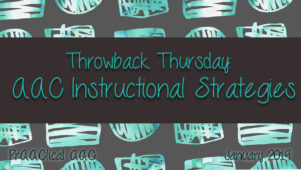
Engaging activities and materials are important in AAC instruction, but the real magic happens when we implement appropriate intervention strategies with fidelity and on a consistent basis. For Throwback Thursday, we raided the archives to revisit some previous posts on several key intervention strategies. Aided Language Input: How Much Language Should We Model? Aided Language Input in AACtion “I’m Using Aided Language Input. Now what??” From Referential to Descriptive Teaching with AAC Learners Recasting: A Language Facilitation Strategy F is for Feedback
October 4, 2018
by Carole Zangari -
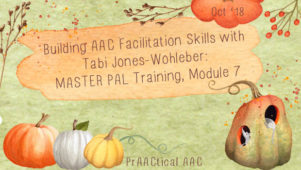
Welcome back to our AAC partner training series, Model as a MASTER PAL, created by SLP Tabi Jones-Wohleber. Today, we continue with materials to help communication partners interact with AAC learners in a supportive fashion. ::::::::::::::::::::::::::::::::::::::::::::::::::::::::::::::::::::::::::::::::::::::::::::::::::::::::::::::::::::::::::::::::::::::::::::::::::::::::::::::: Model as a MASTER PAL Module 7: Engage Naturally Facilitator Guidelines This module covers a lot of territory. From the behaviors of communication partners that support the process of language development to creating communication opportunities, to the language we use with a child to talk about their device, to fostering communicative competence, naturalistic engagement is shaped in many ways. The importance of this conversation lies in the fact that genuine engagement and mutual respect are where learning happens. It is also how meaningful social relationships are built. This module invites participants to reflect on factors that shape the quality of interactions in order to maximize the potential for communicating, learning and creating meaningful social,... [Read More...]
February 23, 2016
by Carole Zangari -
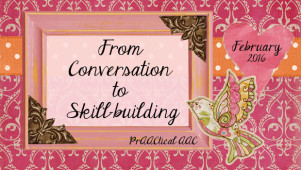
AAC learners need a lot of support as they build the skills needed to have rich and effective conversations. Often, their role in the conversation is punctuated with partners’ reliance on context, prior knowledge, and questions to make sense of the message. What do we do when the learner gives us partial information or uses language skills below his/her capability? Do we accept the limited language so that we get to the bottom of the message our learner is trying to express? Or do we use it as an opportunity to shape improved language skills? One approach to making this decision is to start with a question. “What is the top priority for this interaction?” Making a decision about the most important goal of the conversation is a critical step in determining how to respond. In some cases, the time is right to use the opportunity to improve skills in... [Read More...]
October 27, 2015
by Carole Zangari -
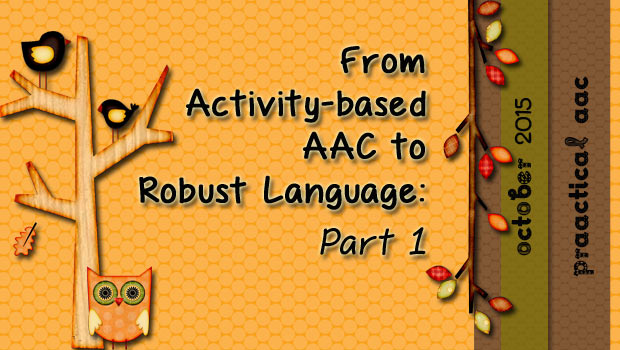
As far as I can tell, most AAC learners are taught by people who don’t specialize in AAC. Their school SLPs may have caseloads of 50, 60, 70, or more students with IEPs, 90% of whom have goals for articulation, language, and fluency. Their classroom teachers serve students whose disabilities range from none at all, to dyslexia to cerebral palsy, to significant intellectual disabilities, and everywhere in between. In all likelihood, neither group had much AAC training. What little AAC they know, they’ve picked up on their own from reading, going to workshops and conferences (usually self-funded), talking to colleagues, and exploring online resources. Many times, their first foray into AAC is with things like choice boards and visual supports, such as daily schedules and first/then boards. From there, they may begin labeling the environment with pictures symbols (e.g., ‘table’ on the table, ‘on/off’ near the light switch), using mini-schedules... [Read More...]
May 30, 2014
by Robin Parker -
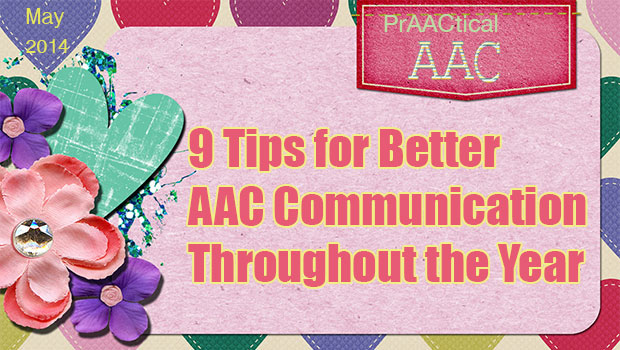
Although Better Hearing and Speech Month is ending, we want to continue best prAACtices in all teaching interactions throughout the year. Here are 9 AAC facilitator tips to help with this goal. Provide Aided Language Input (ALI)– ALI is modeling AAC style. Speak AAC to the AAC user. Use Scaffolding– Scaffolding is a verbal and visual strategy that has the facilitator build upon prior knowledge of the learner in order for the learner to integrate a new concept or skill. Model words and concepts to add information onto what the AAC user already knows and uses. Provide Expansions and Extensions– A form of modeling. Add a word to the spontaneous communication from the learner. The facilitator models a conceptual or grammatical word in the form of a model. Use Recasting– Recasts serve to add or correct information without obstructing the natural flow of communication. Recasting is another form of modelling. The... [Read More...]
November 30, 2013
by Robin Parker -
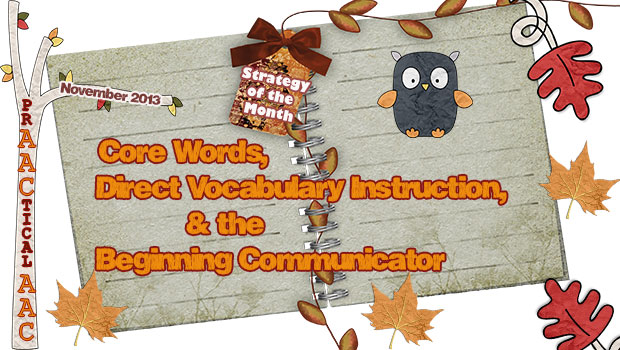
Direct vocabulary instruction is important for all level learners. The beginning communicator needs to learn core word vocabulary from USING the words and one of the best ways to learn how to USE core words, is to receive specific direct instruction with many opportunities for active participation. 6 Essential Philosophies & Strategies Vocabulary instruction involves a systematic TEACHING process. Add vocabulary or Words as an activity on the daily schedule and then have a mini-schedule for the specific vocabulary instruction activities for that day. Initially, apply an errorless learning paradigm. Then, gradually, add comprehension checks, but do not wait for ‘proof’ of comprehension before adding new words because we often notice that the beginning communicator will demonstrate comprehension during ‘unexpected opportunities- or when you are least expecting it. Once learners become familiar with some of the specific vocabulary activities, then have some choice making opportunities as to which ‘word activities’... [Read More...]
September 13, 2013
by Carole Zangari -
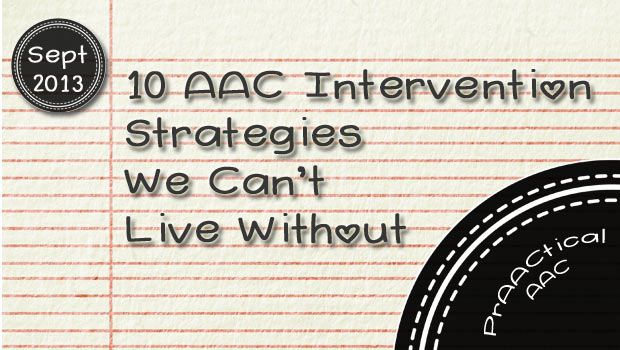
It’s a new semester for us and we’re having lots of conversations with student clinicians about teaching strategies. Here are some of the things they’re putting in their AAC toolkits. Making language visible: Use visual supports to give information, explain, set boundaries, and make expectations clear. Aided language input and focused language stimulation: Teach AAC by speaking AAC. Communication temptations: Make the client want to communicate to get his/her own agenda met Expansions and extensions: The language facilitation strategies we all studied in our language intervention classes work in AAC, too! Repetition with variety: Working on the same thing in different ways is a sure way to build learning and keep treidthings fresh Contrastive examples: Teach through the power of clear examples, both positive AND negative Backward and forward chaining: Great for teaching things that have multiple steps, like sending emails or posting to Facebook Structure: Creating structure helps learner better... [Read More...]
August 31, 2013
by Robin Parker -
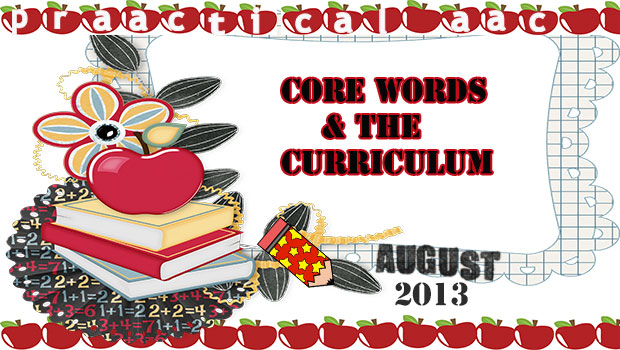
Core words can easily be incorporated into academic curriculum. There just needs to be systematic planning for core word vocabulary and then of course the joining of fringe words. One of the best visual explanations of core words is in the now ‘famous’ you tube video Language Stealers (HD). If you have not seen it, it is worth watching for many reasons but in the context of this post, it perfectly illustrates how you can teach about Greek and Roman history with core words. Planning for Core Words for the Classroom (& ALL School Activities) Have the core word communication board with you at ALL times– If you (SLP/Educator) have your core word communication board, you can model and teach the target core words during all lessons. A premise of this approach is that the student has access to their core word vocabulary display on a no-tech communication board or on their... [Read More...]
March 18, 2013
by Robin Parker -
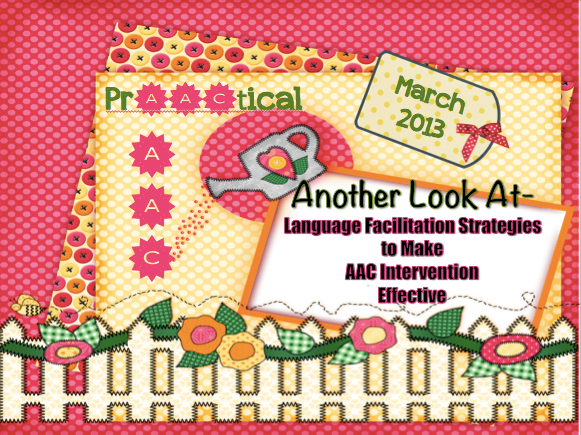
Language Facilitation Strategies The Art of Scaffolding Recasting: A Language Facilitation Strategy F is for Feedback Don’t Miss These Visual Supports & The Chance to PrAACtice Language Facilitation Strategies PrAACtical Teaching Aided Language Input Pivotal Skills for AAC Intervention: Aided Language Input Why We Love Aided Language Input Aided Language Input Demo Learning to Use Aided Language Input Teachers in AACtion- Aided Language Input 5 Ways to Elicit Language Without Asking a Question Don’t Ask: 5 Reasons to De-Emphasize Questions in Your AAC Therapy 5 Tools to Make Aided Language Input Easier F is for Feedback Video
January 24, 2013
by Carole Zangari -
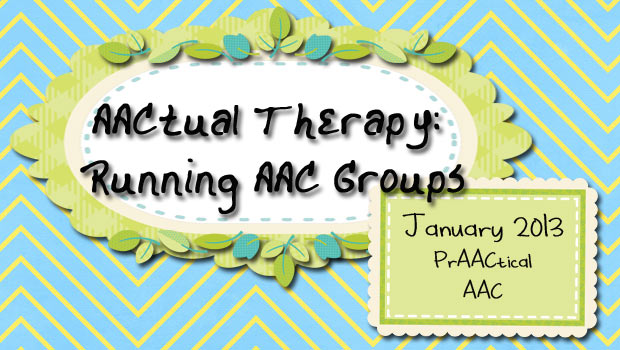
We are just delighted to share the AACtual Therapy of Arizona-based SLP, Deanna Wagner. We’ve known Deanna by reputation for a long while, but got to meet her in person at ISAAC this past summer. She has been involved in the AAC world for over 20 years. Her story as an AAC clinician is an interesting one: “I was lucky enough to attend one of the first university AAC courses, at the University of Wisconsin-Whitewater. My instructor was Dr. Mary Blake Huer, who was a recent president of USSAAC. Because we did not have enough courses in the communication disorders program, I also studied in the special education department and received a graduate degree in severe/profound handicaps. My first job was as AAC evaluator and trainer at Curative Rehabilitation in Wisconsin. I was lucky enough to meet a number of the inspirational team members who made up the model programs for... [Read More...]









